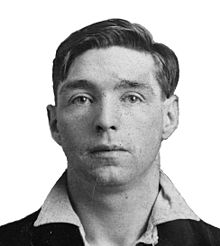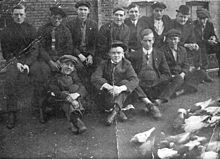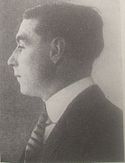- Owney Madden
-
Owney Madden 
Born Owen Vincent Madden
December 18, 1891
Leeds, England, UKDied April 24, 1965 (aged 73)
Hot Springs, Arkansas, U.S.Occupation American mobster Owney "The Killer" Madden (December 18, 1891 – April 24, 1965) was a leading underworld figure in Manhattan, most notable for his involvement in organized crime during Prohibition. He also ran the famous Cotton Club and was a leading boxing promoter in the 1930s.
Contents
Early life
Owen Vincent Madden was born at 25 Somerset Street, in Leeds, England on December 18, 1891. His parents Francis and Mary (nee O'Neil), were also Leeds natives (see the 1891 census). In search of work, the family moved first to Wigan, then to Liverpool. It was Francis' intention to take the family to the United States, but he died before this ambition could be fulfilled. In 1901, Mary Madden sailed to New York on the RMS Oceanic, to stay with her widowed sister Elizabeth O'Neil, at 352 10th Avenue, in Manhattan. Owen and his older brother, Martin, were left at a childrens' home, at 36 Springfield Terrace, in Leeds, until 1902, when Mary could finally afford passage for them. Owen maintained a sentimentality for his native Yorkshire and England throughout his life, refusing to give up his British passport until the 1950s, when he was threatened with deportation. Unlike his elder brother Martin, who adopted a New York drawl, Owney kept his Northern English accent and saved clippings from the Yorkshire Post until he died.[1]
Gopher Gang
On June 4, 1902, Madden, together with his brother Martin and his younger sister Mary, sailed from Liverpool as steerage passengers on board the SS Teutonic. Settling in New York's Hell's Kitchen, Madden joined the Gopher Gang later that year. Described by associates as "that banty little rooster from hell", Madden quickly became a fierce fighter, known for his skill with a lead pipe and gun in fights with rivals the Hudson Dusters. Madden gained the nickname "the Killer" after gunning down an Italian gang member in the streets, after which he shouted, "Owney Madden, 10th Avenue!" Despite the public nature of the murder, no witnesses came forward linking Madden to the crime.[citation needed]
 Gophers c. 1910, Madden back row, middle, leaning forward
Gophers c. 1910, Madden back row, middle, leaning forward
By 1910, at age 18, Madden had become a prominent member of the Gophers and was suspected in the deaths of five rival gang members. His reputation soon gained him leadership of one of the three factions of the Gophers. He was earning as much as $200 a day from the Gophers' criminal activities, such as the gang's protection racket which forced local businessmen to pay in the face of firebomb threats.
During this time, Madden enjoyed an opulent lifestyle, and he was often accompanied by several women. However, he became known for his violent jealousy when he shot and killed a store clerk named William Henshaw, who had asked out one of Madden's girls while on board a trolley. Henshaw initially survived the attack and identified Madden as his assailant. When Henshaw later died of his wounds, police arrested Madden. Though the attack had numerous witnesses, the case had to be dismissed after no corroborating witnesses came forward. Over the next three years, the Gophers reached the height of their power as Madden recruited various gunmen into the gang. As Madden began encroaching into rivals' territory, particularly the Hudson Dusters, he was ambushed and shot eleven times outside a 52nd Street dance hall by three members of the Dusters, on November 6, 1912. Madden survived the attack, however, and refused to identify his attackers to police, stating "Nothing doing. The boys'll get 'em. It's nobody's business but mine who put these slugs in me!" Within a week of his release, several members of the Dusters had been killed.[citation needed]
In 1914, Madden became involved in a dispute with Little Patsy Doyle, a prominent member of the Dusters, over a woman named Freda Horner. In a breach of Irish gangland ethics, Doyle informed police of Madden's operations. Following Doyle's assault on Madden's close friend, Tony Romanello, Madden arranged for Doyle's murder. Madden relayed a message to Doyle through Margaret Everdeane (a friend of Freda Horner) to meet him, supposedly in order to reconcile. As Doyle arrived on November 28, 1914, Madden ambushed Doyle and killed him. The police questioned Horner and Everdeane, who both confessed to their roles in the killing. Madden was eventually sentenced to 20 years at Sing Sing Prison in Ossining, New York. While there, he connected with his old buddies from the lower East side Alessandro Vollero, Joseph Valachi, and his old associate from the Five Points Gang, Jimmy "the shiv" Destefano, who was the Sing Sing death house barber.[citation needed]
Prohibition
After serving nine years of his sentence, Madden was released on parole in 1923. The Gopher gang had broken up, and many members of his own faction were either in Sing Sing or working for bootlegging gangs.[citation needed]
Upon his release he was given a job by an old friend, a former member of Madden's street gang who had moved up to better things. Larry Fay had a sharp mind for crime, however he was not the most physically imposing of gangsters and he needed Madden's muscle to help establish the taxi business he had set up from profits he had made running Canadian whisky across the border during the early days of Prohibition. Fay employed a gang of strong-arm men to help him gain control of the most profitable cab-stands along Broadway and Madden became their leader. Later Fay also became involved in New York's milk trade, attempting to turn its delivery into a racket. Owney Madden learned quickly and soon moved on to form his own organization.
Fay had used Prohibition as a means to raise money for other ventures, but Madden saw it as too good an opportunity to pass up, and soon became heavily involved in bootlegging, establishing a territory in the Hells Kitchen area. In 1924 the Madden gang began highjacking liquor shipments belonging to Big Bill Dwyer, but rather than go to war Dwyer took Madden on as a partner, when Dwyer decided he needed to beef up the enforcement side of his own operations.
The Cotton Club
Madden and his former gang rival turned partner, Big Frenchy De Mange, began to open or acquire some of the flashiest speakeasies and nightclubs of the era, most notably the legendary Cotton Club.[when?]
Madden purchased the Club De Luxe from former Heavyweight Boxing Champion Jack Johnson and reopened it a year later as a "Whites Only" nightclub serving vaudevillian-style black entertainment to the white patrons. Nightclub patrons flooded into Harlem from downtown Manhattan to catch performers such as Cab Calloway, Duke Ellington, Louis Armstrong, Lena Horne, Bill "Bojangles" Robinson and the Nicholas Brothers.[when?]
Madden and his partners, Big Bill and Big Frenchy, also muscled their way into a piece of the exclusive Stork Club, where the influential gossip columnist Walter Winchell held court and everyone who was anyone wanted to see and be seen. As a celebrity nightclub owner with ownership in more than twenty clubs, Madden became well-known and glamorized for his Prohibition-era activities.[2] He also gained recognition for his revenge tactics and payoffs of City Hall.[2]
Boxing
In 1931, shortly before the end of Prohibition, Madden got out of bootlegging and entered into partnership with boxing promoters, "Broadway" Bill Duffy and George Jean "Big Frenchie" DeMange. Between them, they controlled the careers of several boxing champions including Max Baer and Primo Carnera. As Carnera's manager, Madden arranged fixed fights which led eventually to Carnera's winning the NBA World Heavyweight Championship, in 1933. Carnera held onto the title for nearly a year, until reporters' suspicions about fixed fights led Madden to desert the Italian strongman, setting up Carnera's famous defeat at the hands of Baer on June 14, 1934.
Exile in Hot Springs
In 1932, Madden was involved in the murder of Vincent "Mad Dog" Coll, who had been extorting money from several mobsters, including DeMange and Madden.[2] After being arrested for a parole violation that same year, Madden began facing greater harassment from police and encroachment on his territory by Italian Mafia families, until he finally left New York in 1935.[2]
Leaving behind racketeering, Madden settled in Hot Springs, Arkansas which had become known as a haven for various criminals, with a corrupt city government and police force.[2] Madden opened the Hotel Arkansas, a spa and casino, in 1935. He also became involved in local criminal activities, especially illegal gambling.[2] The Hotel Arkansas became a popular hideout for mobsters; Charles Luciano was apprehended there in 1935. Madden became a naturalized U.S. citizen in 1943, and eventually married the daughter of the city postmaster. He lived in Hot Springs until his death in 1965.[3]
In popular culture
- Michael Walsh's And All the Saints ISBN 978-0-446-51815-4 is a fictionalized account of Madden's life, told in the first person, from his arrival in New York to his decampment for Hot Springs in 1935.
- Madden was portrayed by Bob Hoskins in Francis Ford Coppola's The Cotton Club.
- The character Owney Maddox, the Arkansas mob boss targeted by gunslinging DA's Investigator Earl Swagger in Stephen Hunter's novel Hot Springs, is modeled on Madden's later years.
- Madden is portrayed in the 1997 film Hoodlum by Dick Gjonola, noticeably without a Yorkshire accent.
- Orville Halloran, character from Daredevil Noir (see Marvel Noir), is modeled after Madden.
Further reading
- Asbury, Herbert. The Gangs Of New York: An Informal Hiistory of the Underworld. United Kingdom: Arrow Books 2002. ISBN 978-0-09-943674-4
- English, T.J. Paddy Whacked: The Untold Story of the Irish American Gangster. New York: HarperCollins, 2005. ISBN 978-0-06-059002-4
- Kelly, Robert J. Encyclopedia of Organized Crime in the United States. Westport, Connecticut: Greenwood Press, 2000. ISBN 978-0-313-30653-2
- Messick, Hank. Lansky. London: Robert Hale & Company, 1973. ISBN 978-0-7091-3966-9
- Nown, Graham The English Godfather: Owney Madden. London: Ward Lock, 1987. ISBN 978-0-7063-6590-0
- Sifakis, Carl. The Mafia Encyclopedia. New York: Da Capo Press, 2005. ISBN 978-0-8160-5694-1
- Downey, Patrick. "Gangster City: History of the New York Underworld 1900-1935". New Jersey: Barricade Books, 2004. ISBN 978-1-56980-267-0
References
- ^ Nown, Graham (1987). The English Godfather: Owney Madden. Ward Lock. ISBN 978-0-7063-6590-0.
- ^ a b c d e f "The Five Families". MacMillan. http://books.google.com/books?id=5nAt6N8iQnYC&printsec=frontcover&source=gbs_summary_r&cad=0. Retrieved 2008-06-22.
- ^ "Owney Madden, 73, Ex-Gangster, Dead; Owney Madden, Ex-Racketeer, Dead in Hot Springs at 73". New York Times. AP: p. 1. 24 April 1965. http://select.nytimes.com/gst/abstract.html?res=FB0910FA345C147A93C6AB178FD85F418685F9. Retrieved 2010-11-12.
Source
- "1901 census report". Public Record Office. 1901. Archived from the original on 2007-07-12. http://web.archive.org/web/20070712033812/http://upload.wikimedia.org/wikipedia/en/d/d9/Madden_Owney_1901.pdf. Retrieved 2007-05-26.
External links
- Gophers, Goose Chasers, and the Early Years of Owney Madden by Allen May
- Louis Quincy Morse: Gangland Connection ?
- Gangland Tours Owney Madden Video
- Madden's entry at Encyclopedia of Arkansas History and Culture
Alcohol prohibition By country By topic 18th Amendment (U.S. Constitution) • 21st Amendment (U.S. Constitution) • Anti-Saloon League • American Mafia • Dry county • Jazz Age • Islam • Moonshine • Prohibition Party • Roaring 20s • Rum running • Rum row • Rum Patrol • Speakeasy • Temperance movement • Teetotalism • Volstead Act • Woman's Christian Temperance UnionFamous
peopleAl Capone • Mickey Duffy • Purple Gang • Waxey Gordon • Frank Hamer • J. Edgar Hoover • Bumpy Johnson • Enoch L. Johnson • Meyer Lansky • "Lucky" Luciano • Sam Maceo • Owney Madden • "Bugs" Moran • William McCoy • Eliot Ness • Arnold Rothstein • Nicholas II of Russia • Dutch SchultzCategories:- 1891 births
- 1965 deaths
- Depression-era mobsters
- Disease-related deaths in Arkansas
- English people of Irish descent
- People from Leeds
- People from Manhattan
- Naturalized citizens of the United States
- American mob bosses
- American mobsters of Irish descent
- The Westies
- Prohibition-era gangsters
- Gang members of New York City
Wikimedia Foundation. 2010.

